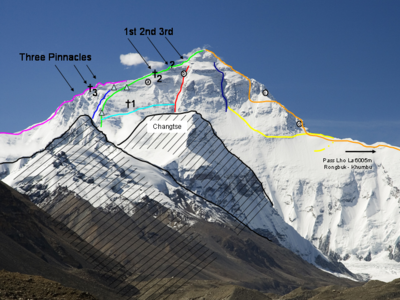Peter Boardman
Peter Boardman (born December 25, 1950 in Stockport , † May 17, 1982 on Mount Everest ) was a British mountaineer , Everest climber and author of various books on mountaineering.
Boardman started climbing as a teenager and first visited the Alps at 16 . He quickly developed into a distinguished alpinist, making the first British climb over the north face direct line of the Olan , the north face of the Nesthorn and the north face fall line of the Breithorn near Lauterbrunnen .
After completing school at Stockport Grammar School, which now has a climbing wall dedicated to him, he studied English at Nottingham University , where he became President of the Alpine Club. Here he undertook his first expedition to the Hindu Kush of Afghanistan , climbed the north face of Koh-I-Khaaik and made the first ascent of Kohi-Mundi. After his time in Nottingham, Peter Boardman studied for a diploma in education at the University of Wales at Bangor , where he learned some Welsh . He was trained as a mountain guide and worked for the British Mountaineering Association. He subsequently became President of the British Mountain Guides Association and Director of the International Mountaineering School in Leysin .
A number of expeditions followed, and in 1975 he climbed the famous expedition of Chris Bonington to Everest via the southwest wall, as part of the second summit team. His climbing friend Mick Burke was killed on this expedition . It is not known if Burke reached the summit - the descending team met him just below the summit, then waited for him at the south summit for some time, but Burke was never seen again.
In 1976 he teamed up with Joe Tasker and climbed the west face of Changabang , probably the toughest climb in the Himalayas at the time. His book about this experience, The Shining Mountain, is one of the most outstanding testimonies in mountaineering literature and won the 1979 John Llewellyn Rhys Prize .
After a failed attempt on K2 , in which Nick Estcourt died in an avalanche, Boardman climbed Kangchenjunga over the north ridge in 1979 (this was also the first ascent of the mountain without bottled oxygen). It went back to K2 in 1980 and reached an altitude of 7975 meters.
Peter Boardman died in 1982 on the northeast ridge of Everest with his partner Joe Tasker . In 1992 mountaineers from Kazakhstan found Boardman's body in a sitting position near the second of the " Three Pinnacles ". He was a sight "as if he were sleeping". Boardman's body was identified from photos by relatives in England. Joe Tasker is believed to have crashed into the Kangshung Wall - he has not yet been found. The task that both of them had set themselves was only solved years later by a huge Japanese expedition with the help of 35 Sherpas : the complete ascent of the entire northeast ridge to the summit of Mount Everest. Boardman and Tasker, however, had tried alpinistically to carry their luggage on the ridge themselves for several days without Sherpa support. Nobody has yet succeeded in climbing the northeast ridge in an alpine way. Your task can at best be compared with the success of the Yugoslav expedition in 1979 on the entire west ridge in the alpine style or with the English expedition of Stephen Venables in 1988 in the Kangshung wall, also in the alpine style - which only with a lot of luck no dead people Mountain left behind.
A second book, Sacred Summits , depicting his explorations from 1979, was published posthumously. The Boardman Tasker Prize for Mountaineering Literature was donated in memory of him and Joe Tasker, who was also a gifted writer.
Web links
- Boardman Tasker Prize for Mountain Literature
- José Luis Bermúdez, 'Boardman, Peter David (1950–1982)', Oxford Dictionary of National Biography , Oxford University Press, September 2004; Online edition, May 2006
Sources, references
- ↑ Stockport Grammar School - an independent school near Manchester, England - Stockport Grammar School pupils reach new heights! . Retrieved October 2, 2008.
| personal data | |
|---|---|
| SURNAME | Boardman, Peter |
| BRIEF DESCRIPTION | British Everest climber and author |
| DATE OF BIRTH | December 25, 1950 |
| PLACE OF BIRTH | Stockport |
| DATE OF DEATH | May 17, 1982 |
